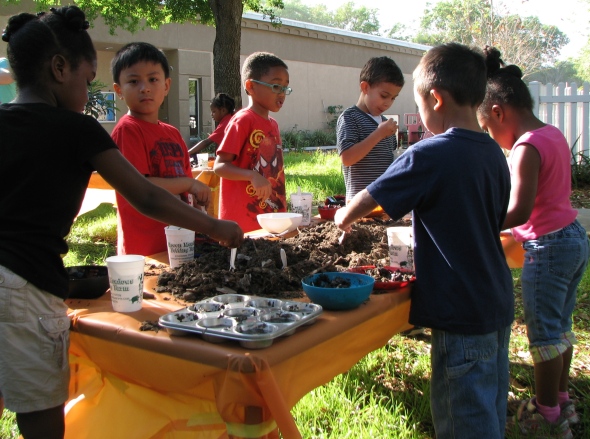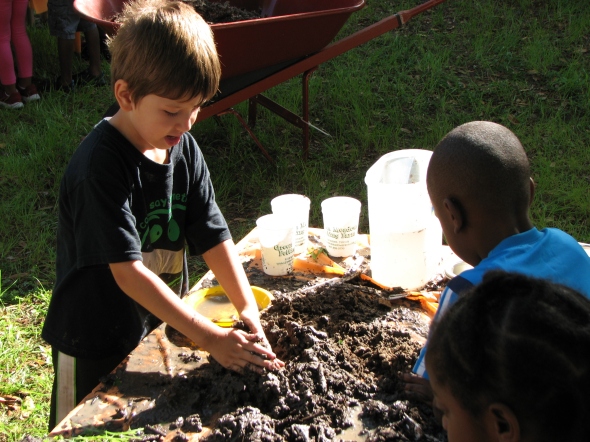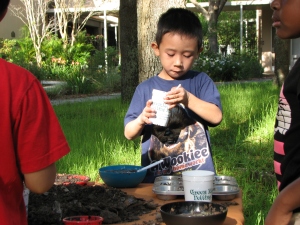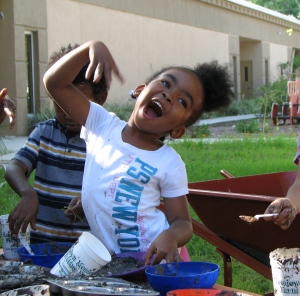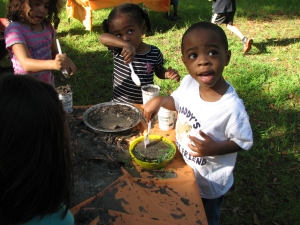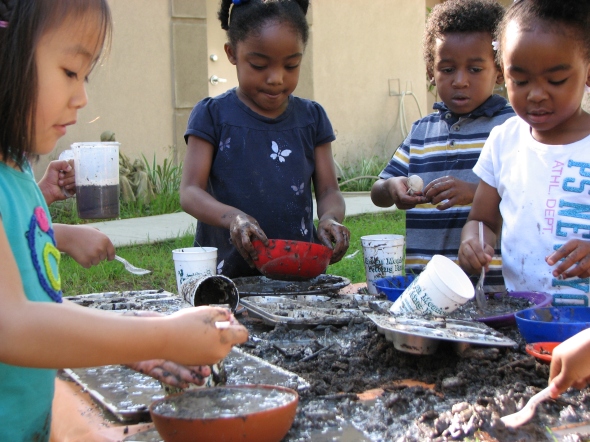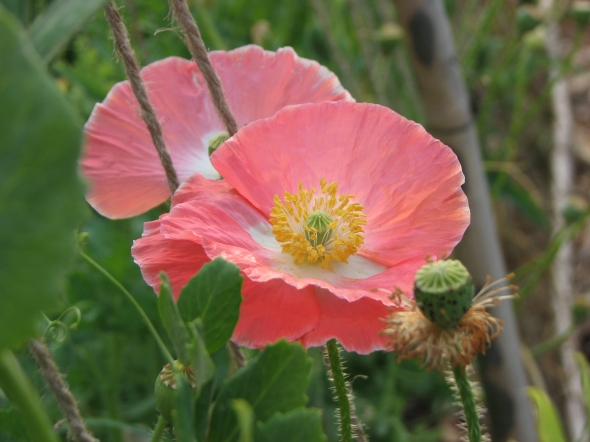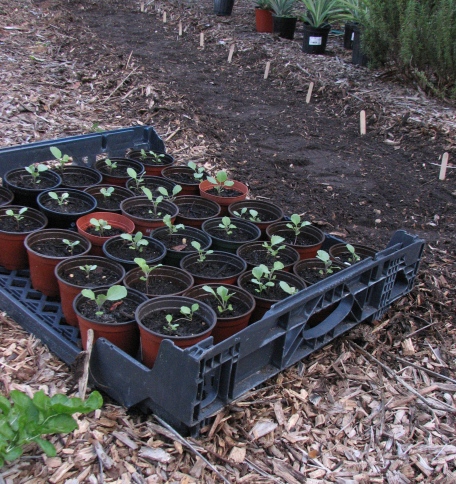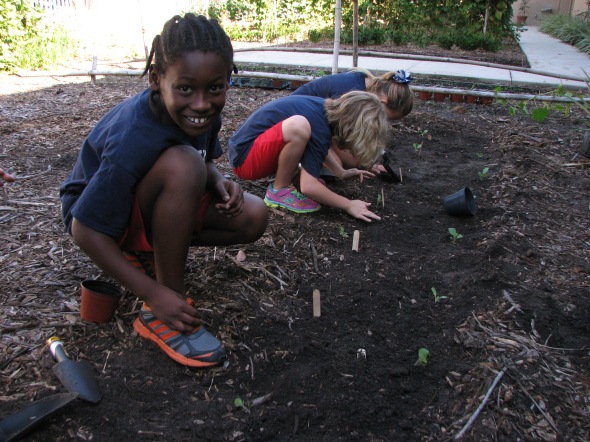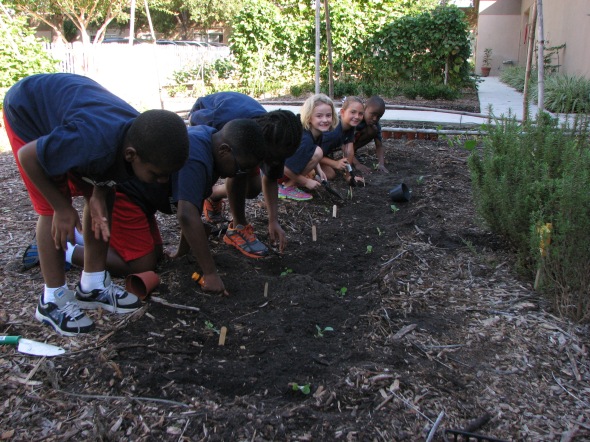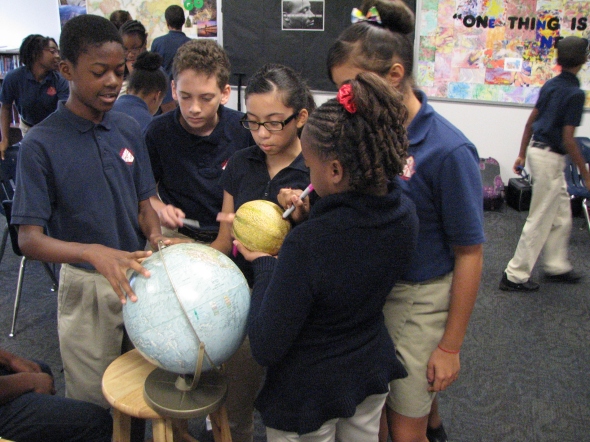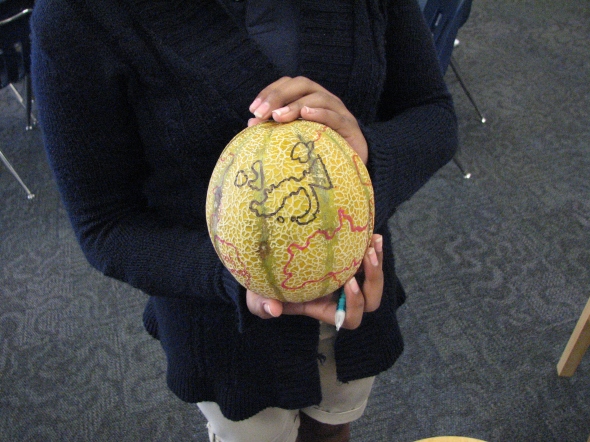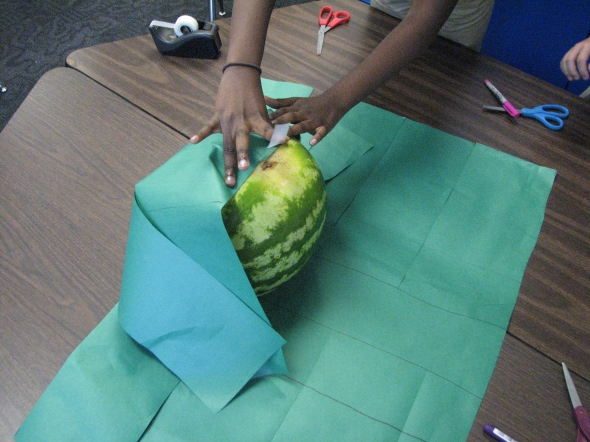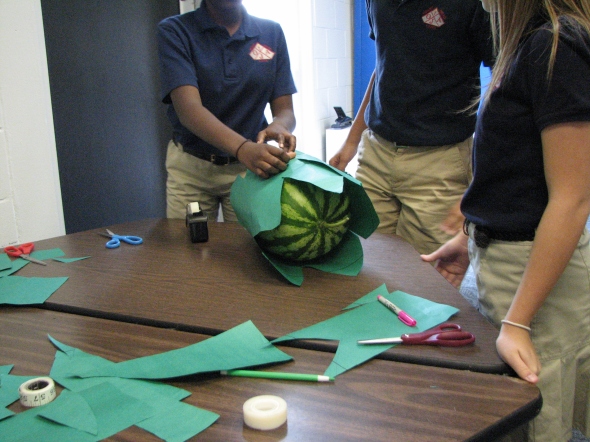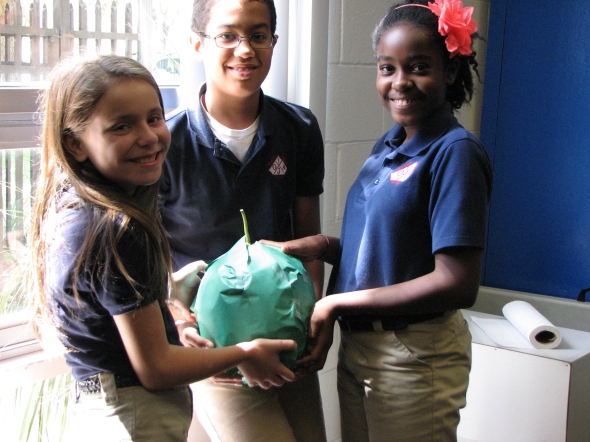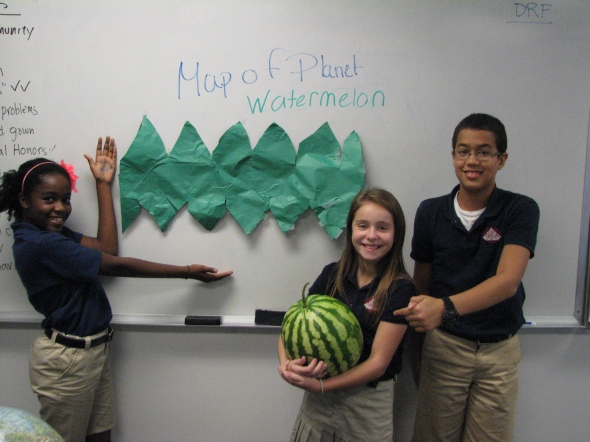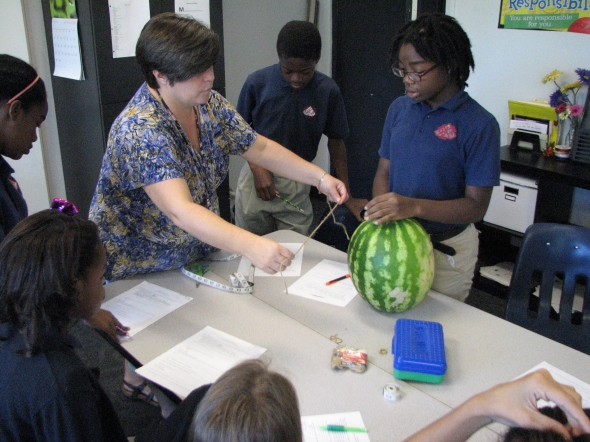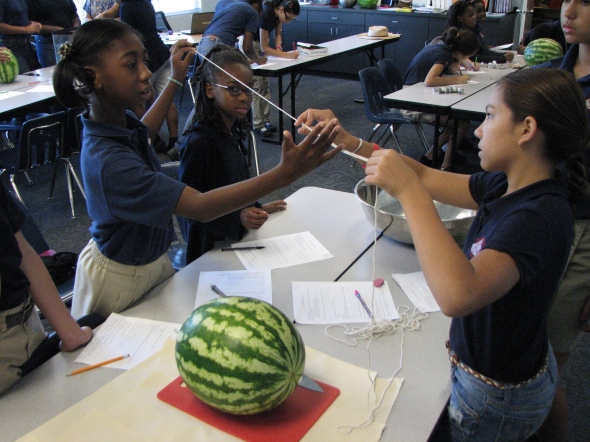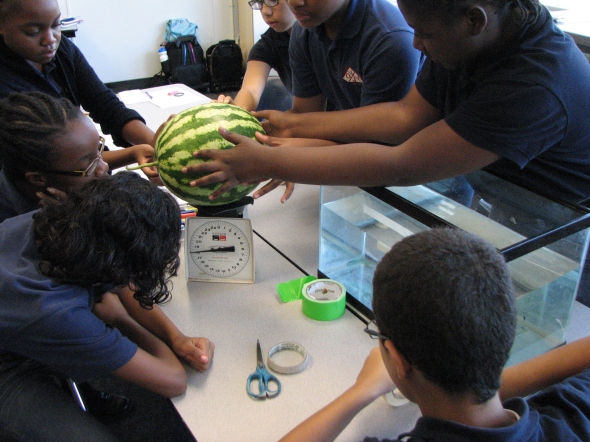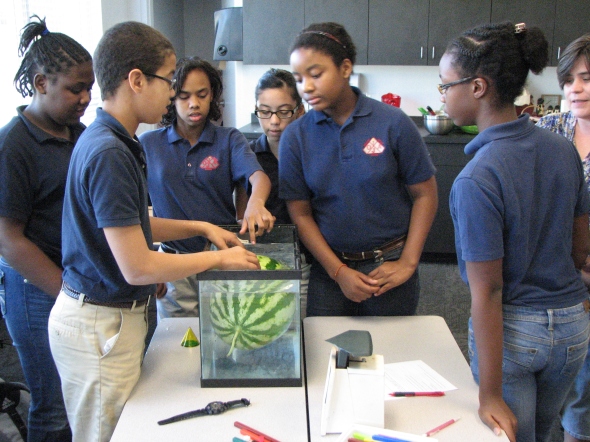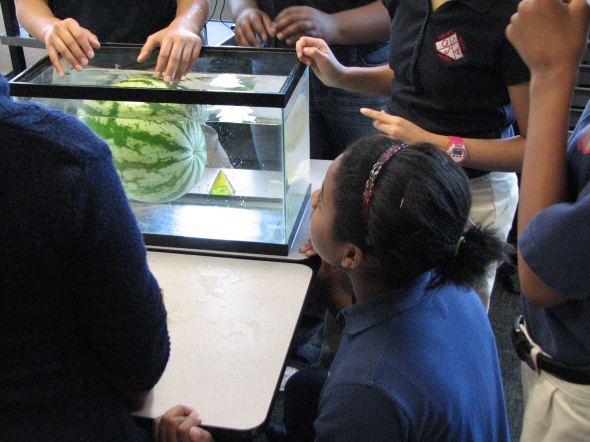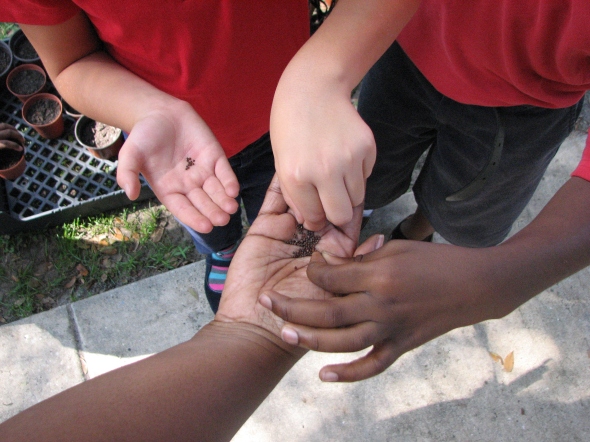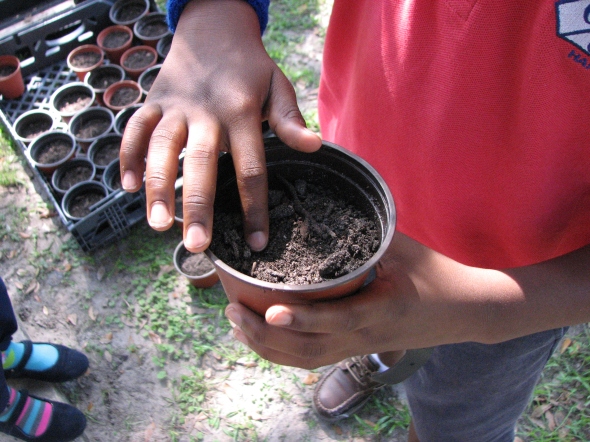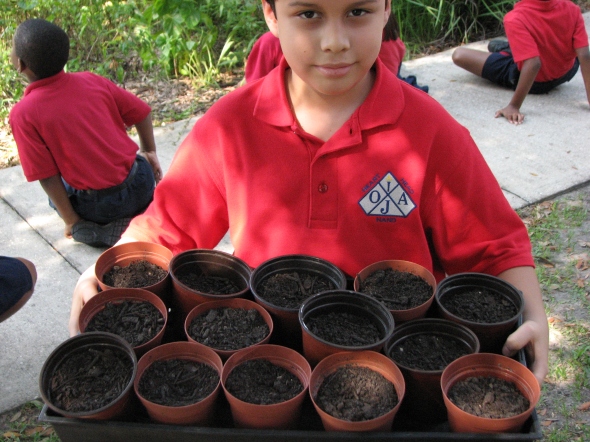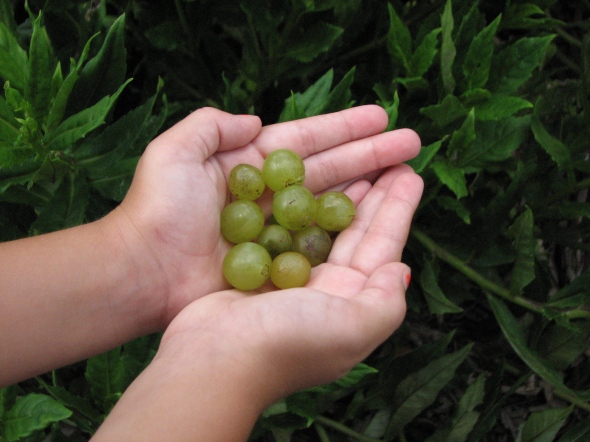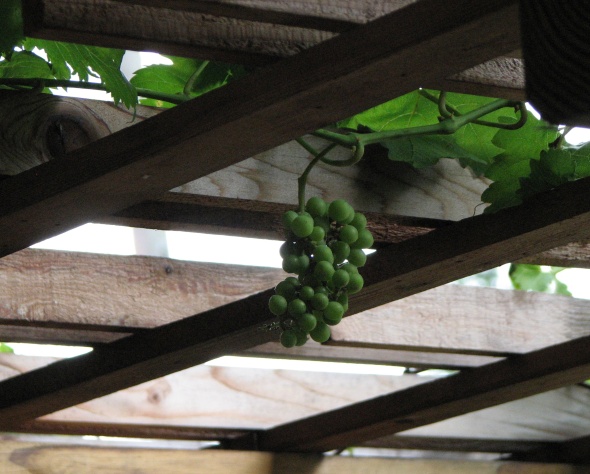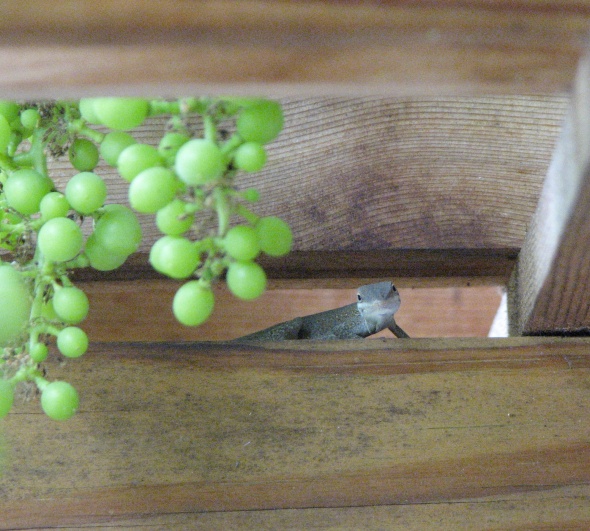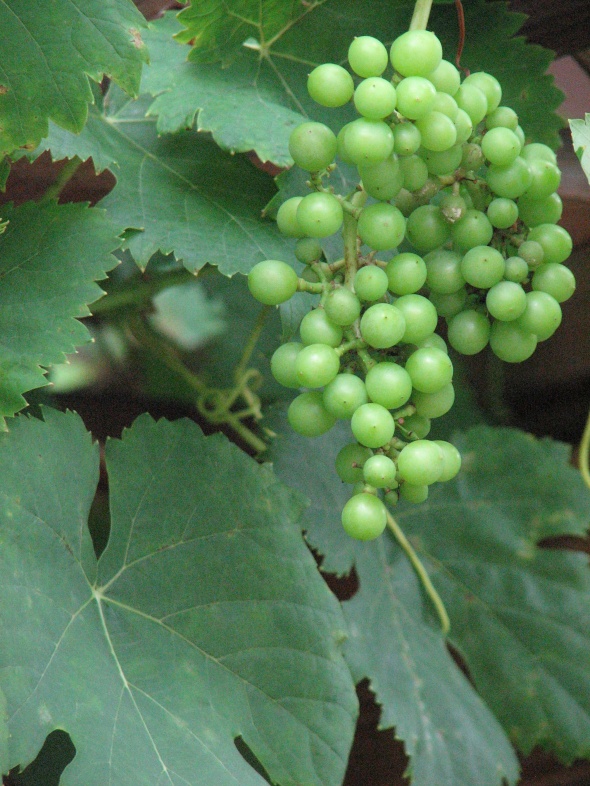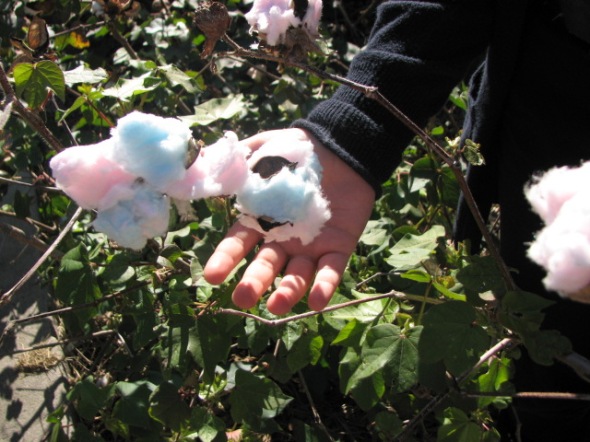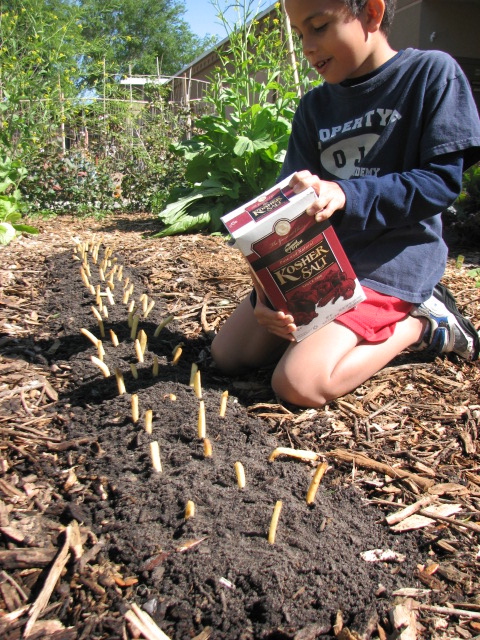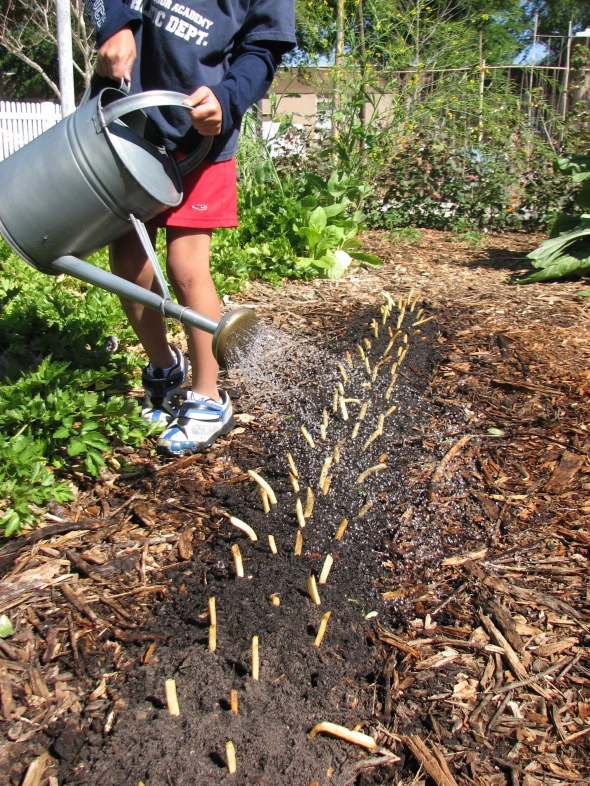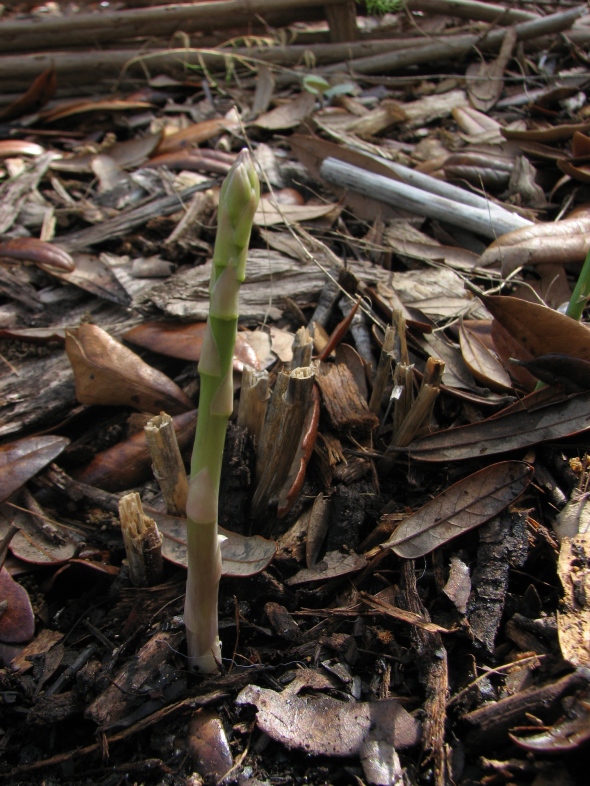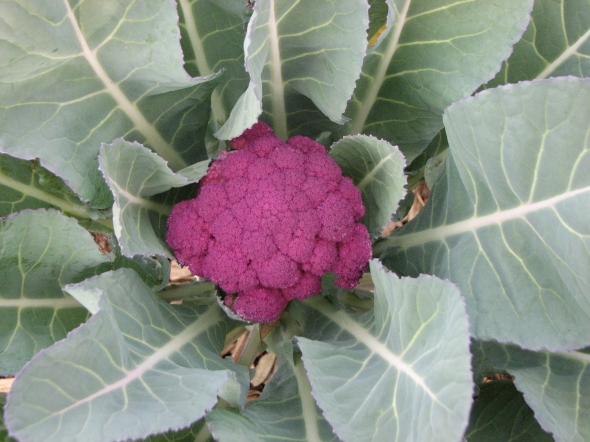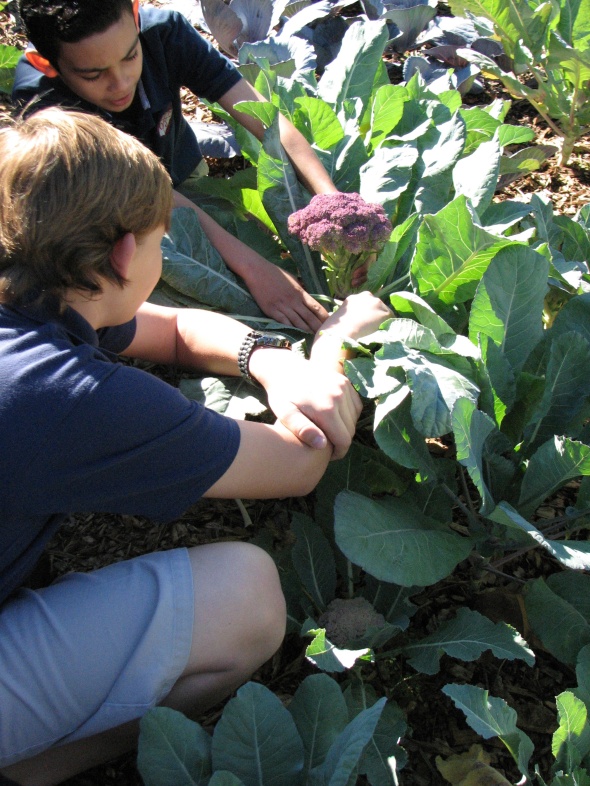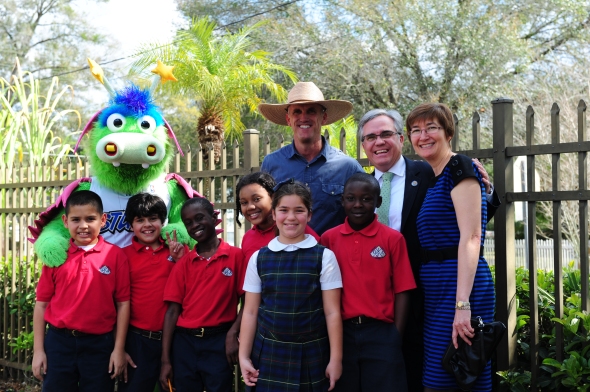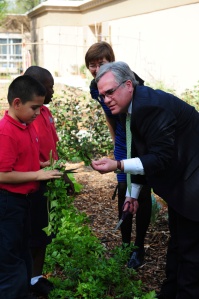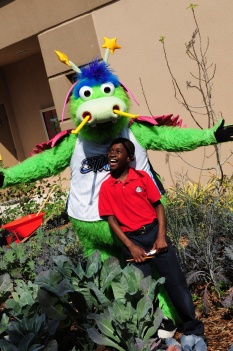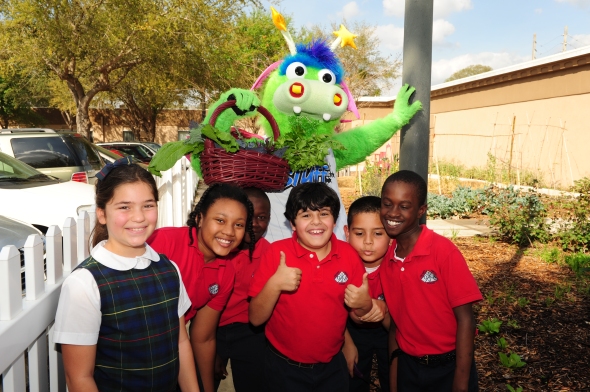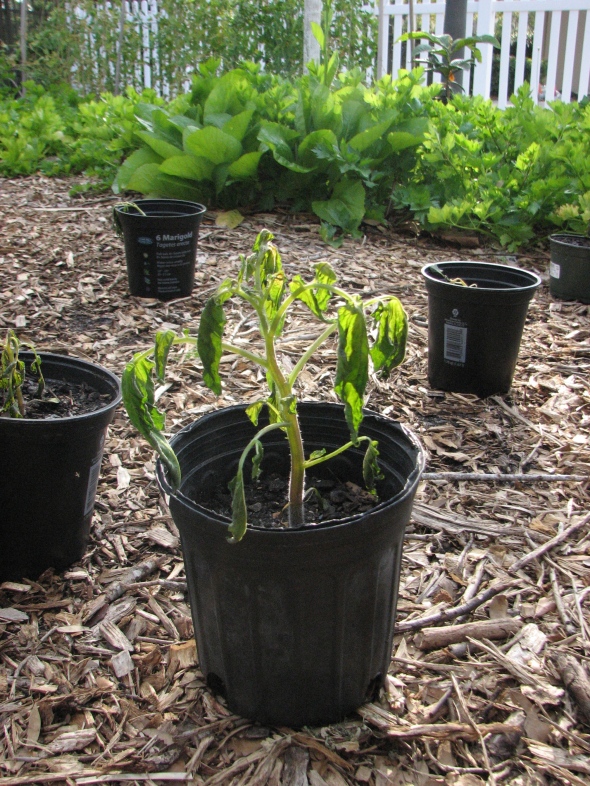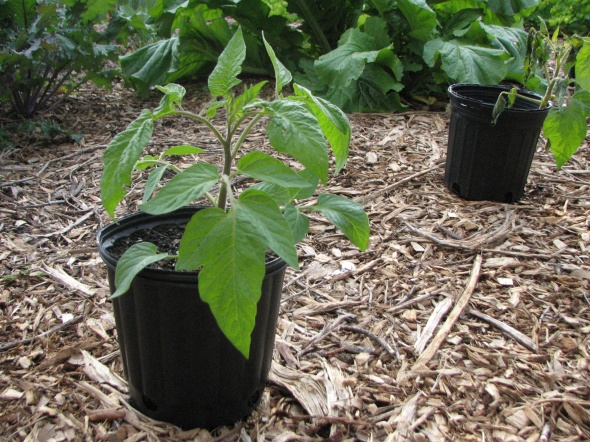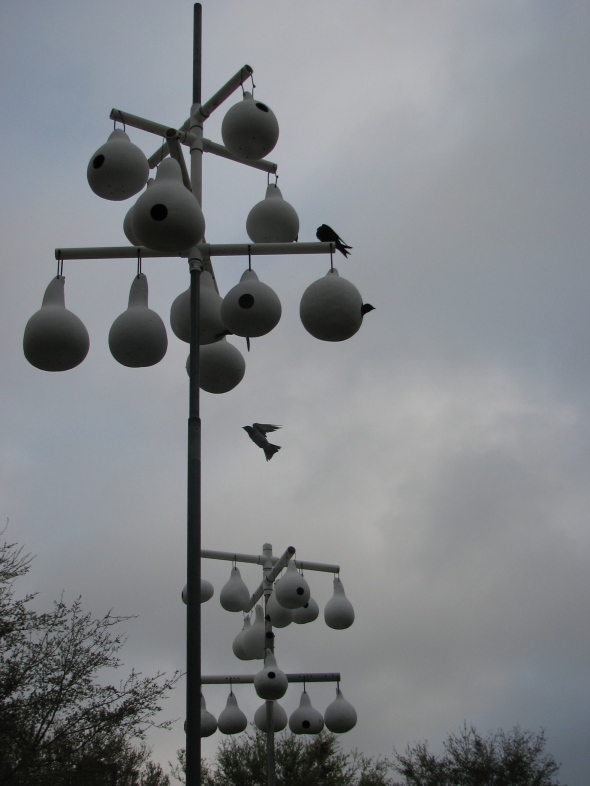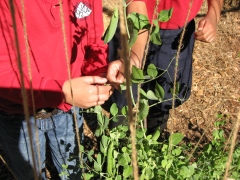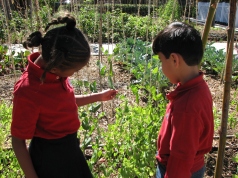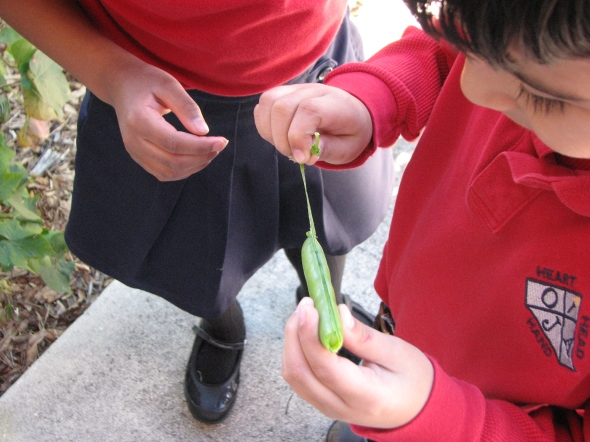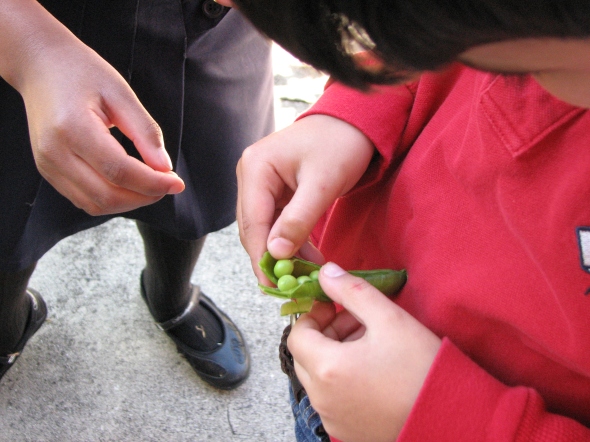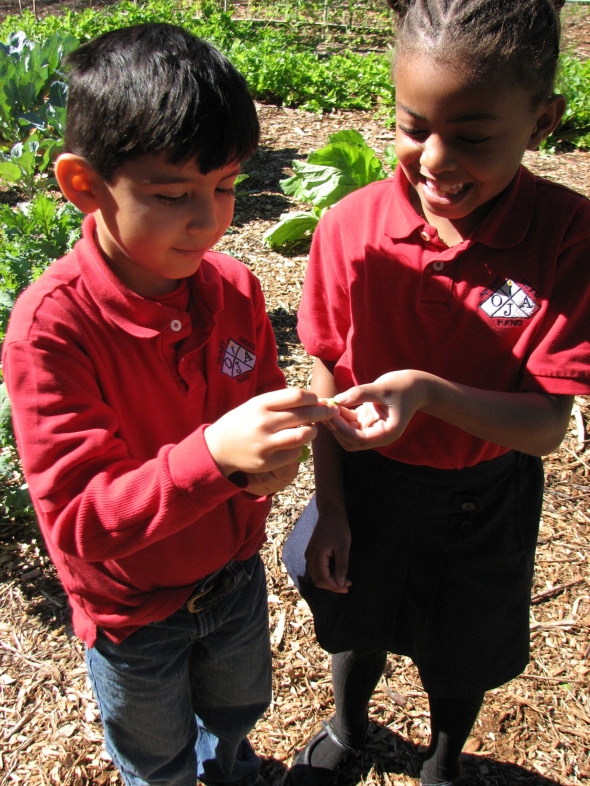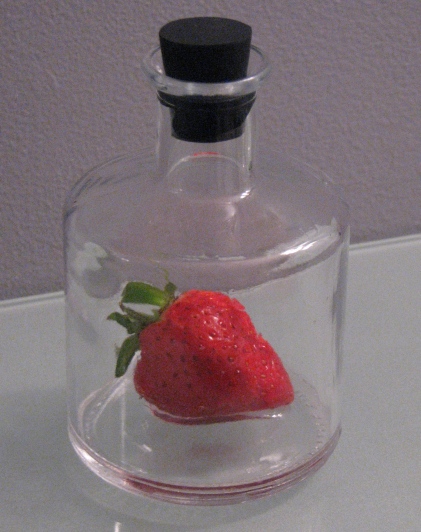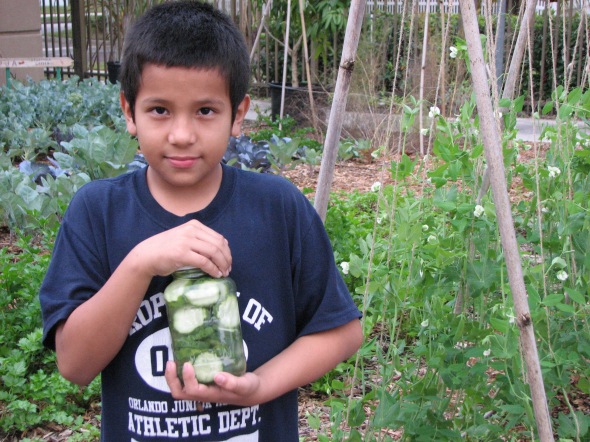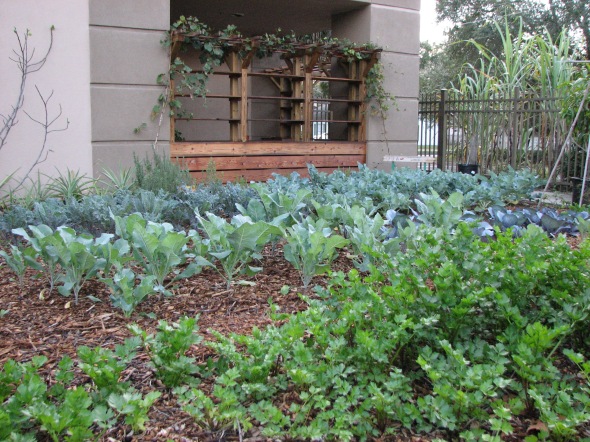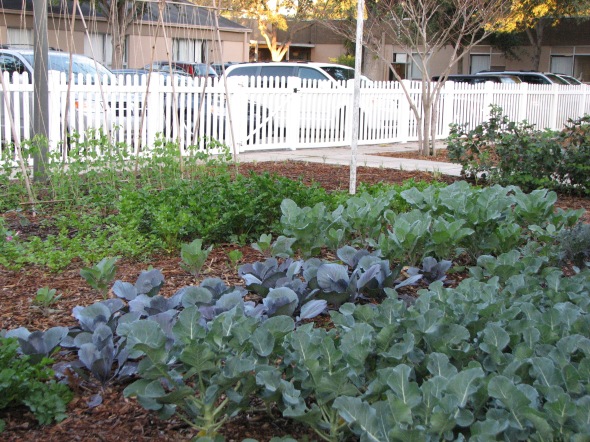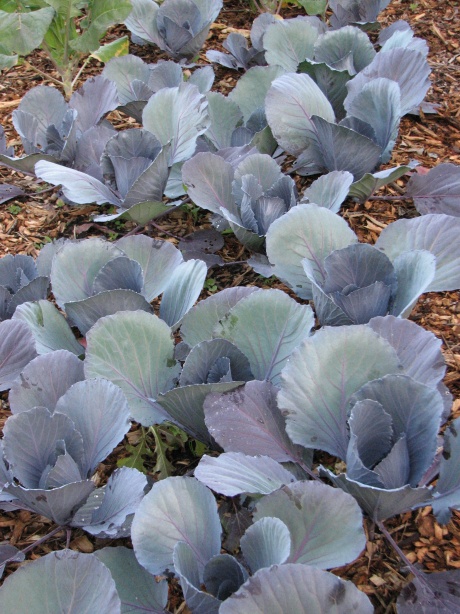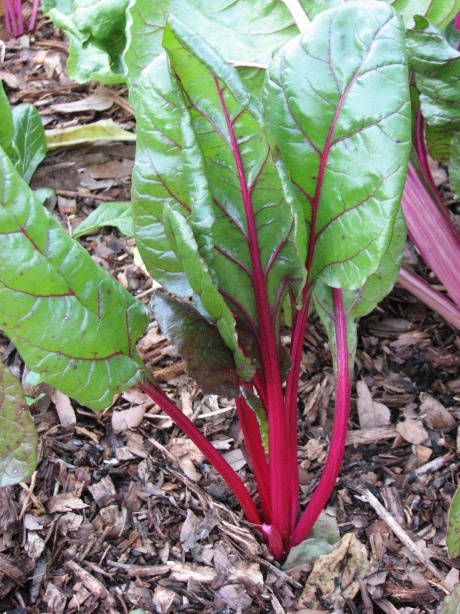Following Through

It’s not surprising that many of life’s most valuable lessons only get half learned. It is simply too easy to divert to a different path rather than follow anything to it’s conclusion. Never have there been so many forks in life’s road. Food lessons are no different. The term “seed to plate” may be on the verge of being overused to the point of meaninglessness but it’s philosophy, which challenges our short attention span, is just beginning to get traction. Looking at the food on our plates and tracing that food’s path back to a point of origin (soil) can be mind boggling. For some, even considering that journey is an epiphany. School gardens not only encourage kids to think about that journey, they invite them to embark on it. By planting a seed and committing to its growth, students learn first hand what it means to bring food to the table. For some foods, a “seed to plate” experience isn’t that much of a challenge. Cherry tomatoes are pretty easy except that many don’t even make it to the kitchen, much less a plate. Some foods require a bit more tenacity. Our last post covered the wheat grown by Mrs. Madrid’s first graders. This morning some of that wheat was finally ground into flour and made it to the plate in the form of pasta.
(Full disclosure: Much of our wheat is still green and not quite ready to harvest and Friday is the last day of school. Bummer. So even though we harvested some of our grain and included it in our recipe, our ingredients were supplemented by a bag of spelt berries.)
These first graders KNOW now what it takes for a seed of wheat that they planted in the fall to wind up as pasta on a plate in the spring. They have imagined it, seen it, smelled it, touched it, and this morning, tasted it. And it was good. All of it.
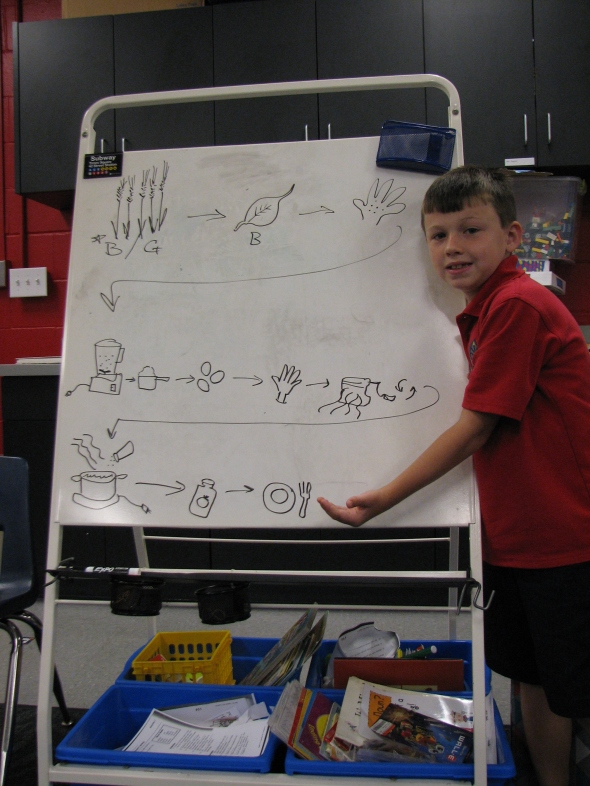
Our visual plan

Harvest

Threshing on a small scale

Gathering basil for the pasta and flowers for the table.

Preparing the “Volcano”

Kneading

Pasta machine
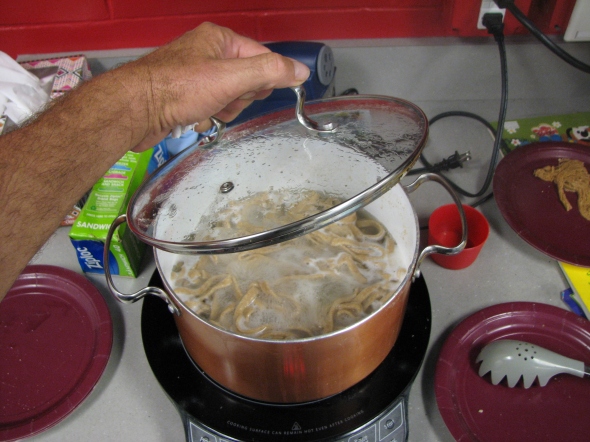
Almost ready

Yum.
Delayed Gratification
Encouraging students to strengthen and stretch their anticipation muscles is one of the primary functions of a school garden. Nature’s gratification is rarely instant but positive experiences in a garden, over time can provide a gratifying sense of accomplishment and satisfaction that is rarely equalled. This can also build patience. Everyone loves a patient child (or adult for that matter) but building patient children is difficult work. It is a delicate balance of challenging students just a bit beyond their comfort, but not so far beyond it that they lose heart and give up.
In the case of Mrs. Madrid’s winter wheat, we almost pushed it too far. From a first grader’s perspective, the time between Halloween and Mother’s Day nears eternity, but this is about how long it took for our winter wheat to reach maturity. Keeping first graders interested in watching grass grow for seven months was no small feat. Mrs. Madrid persevered. On a consistent basis this patience building teacher led her class out to the garden to observe and celebrate the slightest development. Even more frequently she sent two students out to water and report back to their classmates. Occasionally she accompanied her friends out to the garden just for a fresh air reset. Regardless, she was always encouraging these children that yes, in time, the harvest would come. And now…. finally… it has. Now, the possibility of pasta from scratch, from serious scratch is at our fingertips.
Maybe it’s a little cruel to make kids wait so long, (We definitely will add more faster growing plants to the first grade syllabus next year.) but they did it. They waited. They cared. They didn’t lose interest. They were patient. And soon, (very soon) spaghetti will never have tasted so good.

Bringing it Full Circle
If we think of life as a track and field event, it’s easy to see ourselves as long distance runners; bolting out of the starting blocks and leaping over hurdles that challenge us on our way to the finish line. To us, life can start to seem very linear. We learn a lesson, experience painful or joyful moments and then “move on”. Clearly in our own lives, things are not like they used to be and tomorrow, they will not be like they are now. The broader picture of life, however, looks a little less like a marathon and a bit more like jump rope. You know the game where two people are twirling a rope and you have to jump in at just the right moment and hop without tripping for as long as you can. In life we leap into a cycle that started long before we showed up and despite our little vanities will continue long after we stumble out. Things keep coming (and going) around and around. In our annual journey circling the sun we see seasons come and go and then come again. All around us nature is reminding its inhabitants that sustainability is tied to renewal. Nowhere is this more evident than in a vegetable garden. I have long railed against the all to typical (and often only) gardening experience provided to so many young children. A bean seed is placed into a styrofoam cup with some store bought potting soil and placed on a windowsill. While the student does get to see the miracle of germination, more often than not they also witness the desperate, fruitless struggle the undernourished and overwatered seedling makes to break through the glass. In a few weeks the row of shriveled remnants are discretely swept into the trash without the class ever seeing what beans were meant to do: make more beans. When a class of pre-k students can receive pea seeds from the previous year’s class, grow them, eat most of their bounty and save some to pass on to next years pre-k’ers, they can start to see themselves as part of a bigger cycle rather just an individual runner on their own road. This is the first year pre-k has saved some of the seed from their harvest for next year’s class. A class of fourth graders helped them pull pods off of their shriveled (but successful) vines. Already, they see themselves as givers in this game of jump rope. Although I don’t expect to see jump rope as an olympic event anytime soon, this rhythmic pastime will continue to remind me that I’m part of something bigger. So will pre-k’ers and their peas.
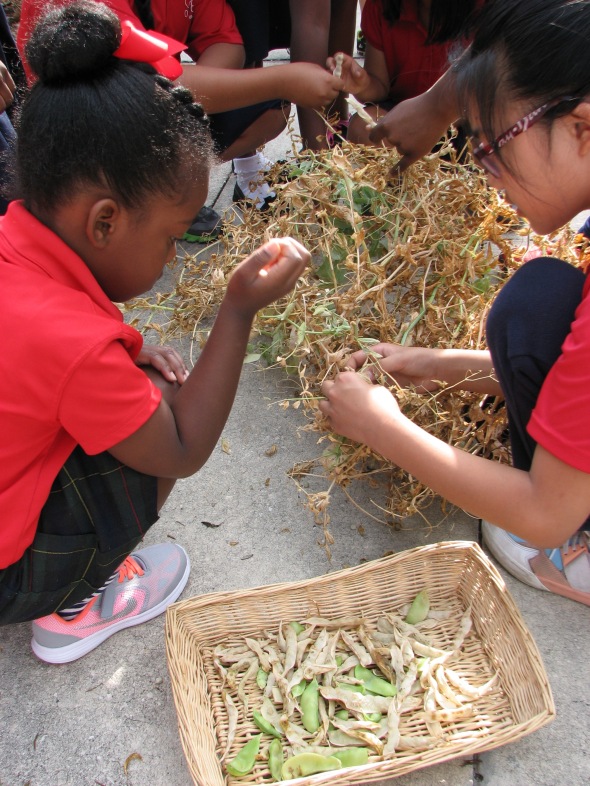
Seeds in Pots
The beginning of every academic year is a bit like a stumbling sprint. Parents, students and teachers alike find getting back into the groove of school a bit of a challenge. There is a lot to do and there isn’t much time to ramp up. You’ll sharpen your pencil twice and it’s Christmas. A school garden is no exception. If your garden is like ours, you may find August pretty daunting. In Florida, summer heat and rains usually give us an overgrown tangle of vines and weeds as a back to school present. Even with attention over summer break there are some plants that just aren’t ready to be yanked out to make room for the fall and winter crops. If you planted crowder peas, watermelon or sweet potatoes just before school let out in May, these varieties are still going strong when students return. Couple this with the fact that August is the most brutal month to be outside in Florida and you can see why it’s tempting to just look the other way. Fortunately there is something that can be done (even indoors) to get some cool weather plants off to a healthy and timely start. Seeds in pots. At OJA we try to plant the bulk of our winter crops in small pots during the first few weeks of school. This allows us to make a start on the new garden while we let the old garden wind down. We have found that many seeds in the Brassica family (kale, cabbage, broccoli, cauliflower etc.) do well when started this way. It might seem premature to start thinking about winter crops now when a trip to the mailbox requires sunscreen, but like I said: “Christmas is coming”. Planting seeds in pots, rather than directly in the ground, offers other advantages as well.
A tray of of potted seedlings is much easier to manage than a twenty-foot row.
It’s much easier to avoid accidentally stepping on a baby cabbage if it’s in a pot.
For some reason slugs and cut worms seem to be deterred by the three inch climb.
Most importantly, planting our first seeds in pots, indoors, buys us time. By mid September the seedlings will need to be transplanted into the ground and the more challenging work of gardening will begin. The garden has already started but we still have time. We still have time to pull out weeds and decide where the beds will be laid out. We still have time to discuss garden protocol and outdoor learning expectations. We still have time to plan, time to imagine. We still have time to get back into the groove of school.
Kitchen House Update
Horizons are often difficult to judge. Sometimes things that seem far away turn out to be just over the next hill while other things that seem to be right at hand wind up being miles away. So it is with time. A deadline that seemed an eternity away is suddenly tomorrow and an idea that appeared so far away, surprisingly pops up into view. The Edible Schoolyard at OJA is experiencing just such: an exciting, long awaited, sudden development. Our team has long believed that our student’s cooking experience could be greatly improved by providing them with a true kitchen classroom. We have felt that the surrounding community might also enjoy this “seed to table” experience. We had faith that there were others who share our belief in edible education and would partner with us to create a vision of something new. This vision is quickly coming into focus in the form of a “kitchen house” and “give back garden”. An idea that once seemed “miles away” is suddenly on our doorstep. Through generous partnerships with Florida Hospital for Children and the Emeril Lagasse Foundation, we are creating an innovative space where students will be given the opportunity to learn about the source of their food. These students will also have a hand in growing and preparing that food, which we believe will inspire a healthier and more delicious lifestyle. Here are some architectural renderings provided by our design team partners, Midtown Architecture Studio and Hunton Brady Architects. 

 Since this project lies on a plot of land across the street from the school our students will not be the only ones able to utilize this facility. Other schools will be invited to enjoy this space as a field trip destination without any compromise to our own campus routine.
Since this project lies on a plot of land across the street from the school our students will not be the only ones able to utilize this facility. Other schools will be invited to enjoy this space as a field trip destination without any compromise to our own campus routine.
Dirt Day in Pre-K
Mrs. Webster’s Pre-K class recently enjoyed their day in the dirt. Tables were placed just outside the classroom with a wheelbarrow full of soil and some buckets of water standing by. One student, before the festivities, was overheard telling Mrs. Webster that he didn’t like getting dirty. Mrs. Webster just smiled. Behold the power of mud. It was no time before little hands and big imaginations dug in to create oatmeal and chocolate milk, cookie dough and pizza pies. Chocolate seemed to be a theme on the menu and it turns out everything tastes better with a garnish of grass clippings.
It may seem that these children are only having fun, but there is an underlying lesson. It’s a subtle message but one that is fundamental. Soil is the source of all that we eat. The sooner we can introduce this to children (even through play) the more likely they will value healthy real food and respect the process that brings it from that source to their table. In the mean time, bon appetit!
Tempis Fugit
Time runs from us. It usually takes off in a sprint while we’re looking the other way. Moments quickly pass through our fumbling fingers and we rarely take notice. We’re drawn to details that seem permanent and ageless because they help distract us from the uncomfortable ticking clock. In reality though, building our lives around this distraction is a trap of denial. You can’t stop that clock, no more than you can stop that beautiful sunset. Ironically, part of what makes that sunset so great is that it runs away and doesn’t last. It’s unfortunate that we sometimes associate the temporal with the disposable. We question the value of things that don’t last. In our disposable culture that’s usually a reasonable question, but a sunset is not a paper plate. A melting snowflake is not a plastic fork. The natural world is full of the temporal that calls our attention to time not away from it. For some, the seasons are a drastic reminder of how nature seems to celebrate time. Floridians, however, have to look a little closer. So much of our landscapes here have been designed to appear unchanging. While pursuing the holy grail of the “maintenance-free yard”, we have wound up with an environment that looks pretty much the same in January as it does in July. What a shame. The passage of time should be celebrated. Poppies can help. They don’t last. Look the other way and you’ll miss the party.
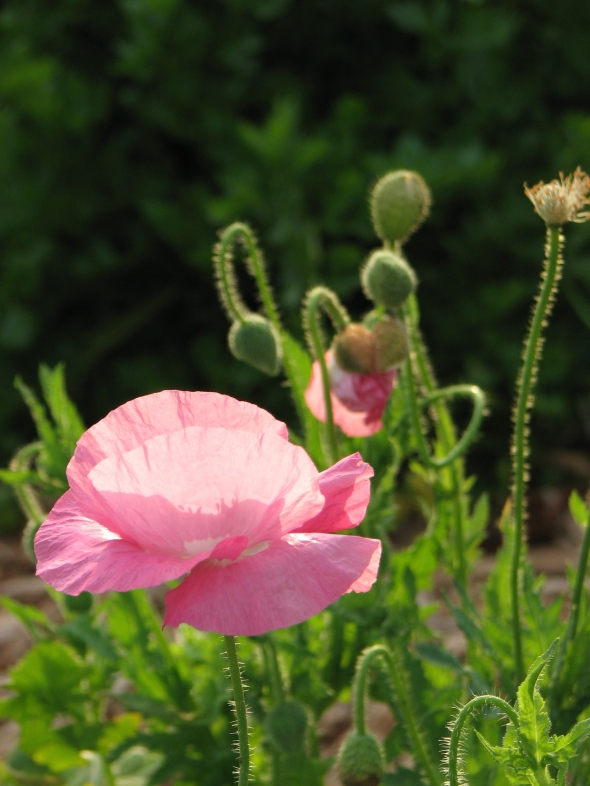
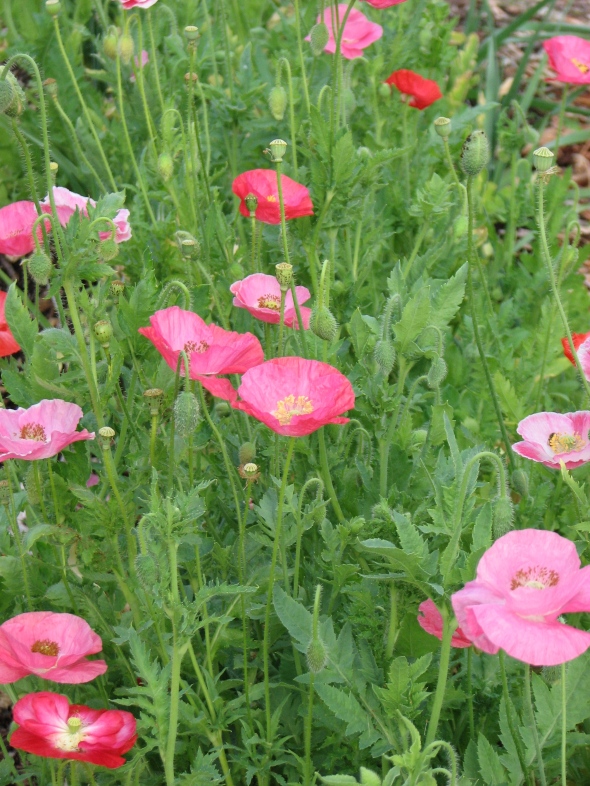 Scatter poppy seeds in the Fall and you’ll notice when Spring arrives.
Scatter poppy seeds in the Fall and you’ll notice when Spring arrives.
Planting Seedlings
Dropping a seed into a pot is pretty easy. Transplanting the seedling that results is a bit more of a challenge. These third grade students were up to the task.
Watermelon Geography
You must be thinking this is a stretch. It isn’t really. Aside from the obvious questions about where watermelons originated and the climatic and seasonal requirements necessary to grow these vines successfully, there is an interesting opportunity to use a melon to discuss our planet’s shape and how it’s surface is portrayed in maps. Many times students overlook the subtle but significant differences between globes that sit on a table and flat maps that hang on a wall. Anytime a three-dimensional object is portrayed in a two-dimensional medium, distortion is inevitable. To highlight this distortion students were asked to first draw the continents on small cantaloupes (a surprising challenge very different from drawing them on a sheet of flat paper). These will later be sliced into sections and eaten. The skins will then be spread out on a flat surface to see how this changes our perception of the drawings. A few students were asked to wrap a flat sheet of paper around a watermelon and find the necessary alterations that must be made to the paper to avoid any over lapping surfaces. This was an interesting task as these students had just come from math class where they had been using this same watermelon to discuss the measurement of surface areas. Now they were thinking of this surface area as a map of Planet Watermelon.
Watermelon Math – Part Two
We don’t often think of math as a form of communication. Words, not numbers, are usually the first to come to mind when we think of sharing information or ideas. For instance, when we want to tell someone about a newly harvested watermelon many adjectives spring to mind: sweet, juicy, fat, red, striped, delicious etc.. However as soon as we say “bigger than a bread box” we are, even subconsciously, using math as a way to describe or communicate information about our watermelon. Obviously, a bread box is hardly a consistent unit of measurement but it instantly tells you something about our success by way of mathematical comparison .
As part of our Watermelon Math lesson we challenged our upper grade students to think about numerical ways of describing these fruits and using standard units of measurement to communicate their findings. Estimation was a great way to start this exercise. Having students guess, often builds momentum for discovery. It is challenging to describe the chaotic energy of these students as they worked and it’s difficult to measure the “light bulb” moments in kilowatts. They may not remember the formulas they used or the numbers they calculated but hopefully, more importantly, they will think differently about the concepts of circumference, surface area, weight and volume. They will probably think differently about watermelons as well.
Many might say, “Do you really need a watermelon for this exercise?”. Of course not, but if you’ve never brought watermelons into a middle school classroom (which has been watching those melons swell for the last month) you are really missing something. It kind of makes you feel sorry for those poor students who are stuck with measuring styrofoam spheres.
Seed Planting Blitz
Of course the clock is ticking. It’s always ticking. It just seems that this time of year the ticking gets louder when you realize that winter is coming. Obviously, most of the country will scoff at Floridians who use the word winter to describe the months of December through March and in this heat those Floridians will have a hard time even remembering what winter is. Their memory will be compromised in fevered brains as they try to navigate the delirious summer haze of the Target parking lot without having a stroke. It’s easy to forget about frosty mornings when the daily rainstorm has left the asphalt literally steaming. Nevertheless, frosty mornings are coming and even cold hardy crops need to be established before it gets cold. Therefore, we’re planting seeds and we’re planting lots of them.
Tick Tock!
On your mark, get set…….
Here we go again. The first day of school is a new verse to a very old song. Pencils are sharpened. The walls have a fresh coat of paint. There may even be 64 crayons in the box. It all seems so new,….. but is it really? Yes and no. The thrill/terror of entering a new classroom on the first day is anything but new. OJA has been doing this for a while and has had over one hundred “first days”, each with its share of excitement. Because of this, Monday won’t really be the first day of school. It won’t be new…. and yet it will be. It will be “new” because it’s a long first walk from the car to the classroom for many of our students (and an even longer walk back to the car for many of our parents) “New” is a big deal. There’s been a palpable buzz on campus as teachers have prepared their classrooms because “new” is a big deal. Even the eighth graders, who have been here for a while, recognize Monday’s importance because “new” is a big deal. It’s a new chance, a fresh start, a clean slate, but it is, again, an old school. It’s an old school with a rich culture, one that’s taken years to develop. Generations of parents, teachers, church members and friends have invested the resources that make OJA what it is today, a place where children are challenged and comforted, a place where excellence isn’t just expected it’s anticipated and celebrated, a place where students are loved. OJA is an old place that makes “new” a big deal.
It’s just like the garden. (Come on, you knew that was coming.) Now is the time to start our fall/winter garden with a seed planting blitz. It’s hard to look at a fresh plot of black soil raked smooth and not think: “clean slate” or hold a tiny seed between your fingers and not think: “brand new” or smell the rain and not think: “fresh start”. It all seems so new…. but is it really? The complex history within a handful of our garden soil could be discussed for days. The seeds that we plant are the inherited product of generations of farmers and gardeners who selected and saved seeds; each year planting only the best of the previous years crop. Even the rain has been through countless cycles of condensation and evaporation before falling on our patch. Gardens are old with a rich culture that’s taken years to develop. Children have been learning to grow food for a very long time, but anytime a child pulls their first carrot out of the ground the whole world seems brand new. Our garden isn’t new……but it is and “new” is a big deal.
Great Expectations
We have to admit, growing table grapes in Orlando seemed a little far fetched, until we saw one (yes, just one) gardener doing it. Click HERE to see who it was. Suddenly it became not just possible, but probable. That’s the crazy thing about looking around at what others are doing. It raises the bar. Of course trying to “keep up with the Joneses” has brought misery to many, but seeing what others can do and are doing eliminates the common cynical excuse of “We can’t do that.”. Of course we haven’t tasted these yet, but we have high hopes. Look around. See what’s possible. Be inspired. Give it a shot.
April 1st Update
In the spirit of “If you can’t beat’em.. join’em”, OJA has hopped on the GMO bandwagon! In case you aren’t familiar with the acronym, GMO stands for genetically modified organisms. These are living things that have been improved by having their DNA spliced with the DNA of some other living thing. It’s like getting the best of two creatures in one! (without the hassle of species differentiation) Our students are definitely reaping the benefits of this ground breaking technology.
As many of you may already know, for several years we have grown cotton on our campus. We also have an expanding stand of sugar cane. Wouldn’t it be great if these two species could be introduced to each other in a lab and come together to make something truly useful?
Surprise! Organic Cotton Candy
Students are loving our recent addition, and there’s no need for a cotton gin. The seeds taste like Red Hots!
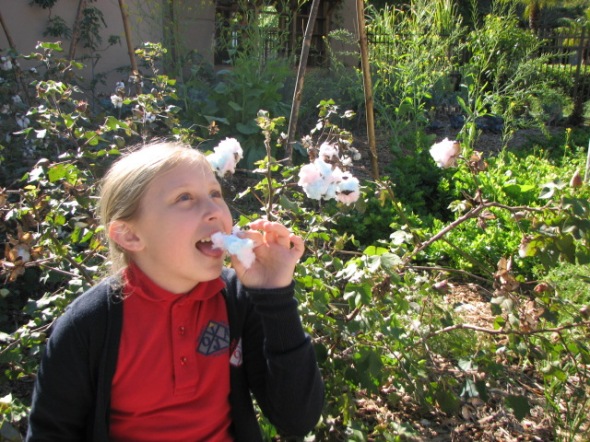 It’s even harder now to bring students in from the garden.
It’s even harder now to bring students in from the garden.
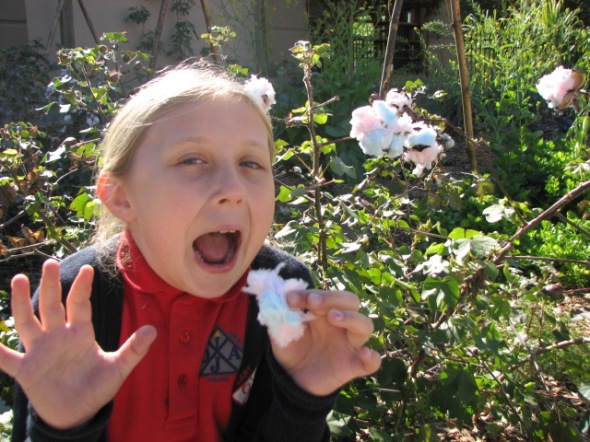 Added bonus: The students return to class with an extra “boost” of energy that the teachers love.
Added bonus: The students return to class with an extra “boost” of energy that the teachers love.
We’ve also acquired seeds to a newly patented vegetable that blends the starchy goodness of a potato with the convenience of asparagus (which frankly… if asparagus weren’t so easy to pick, no one would eat it.) Behold: Potatogus Crispicus, commonly known as the french fry plant.
Here’s a helpful hint: For smaller patio gardens consider the variety “shoestring”. They do great in pots. Also, if you choose “curly fries” we recommend you provide a trellis for them, as they tend to flop when grown unsupported.
Of course these delicious cuttings will need condiments and fortunately Heinz has pushed the scientific envelope. (or should we say “squeezed the packet”) We now have as part of our sponsored test garden a plant that makes it possible to grow our own ketchup! For too long the tomato has been an unecessary and inconvenient step in the “seed to red goop” process. With no refrigeration necessary and no expiration date, this is something really worth growing.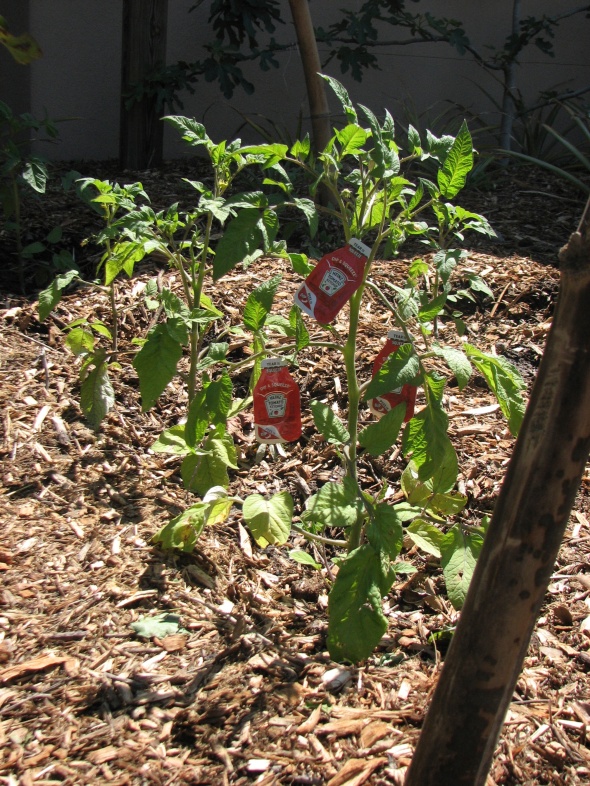
We’re not sure what other DNA was added to a tomato plant to make this marvel. We’re not even sure it was DNA, but hey, we know better than to ask questions about our food.
So, what’s your favorite GMO? Add yours in the comment section.
On Fire for Education
What may appear, at first glance, as an emergency crisis is actually a well planned training exercise. Like Orlando Junior Academy, the Orlando Fire Department recognizes the value of hands-on experiential learning and was able to benefit last week by setting this old house ablaze. OFD has eighteen new recruits that were able to train in a “live fire” scenario in an actual residential structure, which is a rare and valuable opportunity. The house itself is located across the street from our school’s gymnasium and sits on a double lot. OJA owns this property and is looking to expand the current Edible Schoolyard program to address the needs of the greater community. Rather than simply bulldoze this building down, OJA realized it could be used for educational purposes by the fire department. Since it is OJA’s desire to be engaged in its community and partner with those who make that community a better (and safer) place to live, OJA agreed to let the fire department have free access. None of this would be possible of course, without the generosity of Florida Hospital and Brasfield & Gorrrie, who have agreed to support our Edible Schoolyard by removing what is left of the house and preparing the lot for future development. These are the kinds of partnerships that we see as being vital not only to the success of our school as an institution but to our graduating students as well. It is our hope that children leave OJA with the desire to be an integral part of their community, receiving graciously and giving generously, equipped and inspired to make a difference.
Promises, Promises
There are many aspects of gardening that encourage the development of patience. Gratification is hardly instant in food production. Rarely, however, are patience and restraint required to partner together so desperately as when dealing with the agony of growing asparagus. Fresh asparagus is certainly worth the square footage required to grow it and of course good soil and seeds are hardly a sacrifice. The time one must wait to actually eat it, however, is ridiculous. Most gardeners are ready to accept the fact that after the average vegetable seed is planted, there is no need to set the table for at least a couple of months. This flies in the face of our “fast food” culture but it’s doable. Asparagus on the other hand gives “slow food” a whole new meaning. If you’ve been reading this blog for awhile you may remember our students planting asparagus seedlings in our garden. Click here to read about it. Yes, that’s right, it’s been almost a year. To this date the amount of asparagus that’s been eaten or should we say “tasted” from that planting would not equal a single serving size. The goal with asparagus is to let each plant develop and grow to the size where it won’t miss a few shoots of new growth each spring. Asparagus is a perennial plant that, when mature, can produce for twenty years but it can take two or three years before it reaches maturity. Even worse is that while waiting for that to happen, these plants send up shoots that look like the one pictured above. You know it’s crisp. You know it’s juicy. You know it’s delicious. You know that asparagus is the vegetable of kings. You know you can’t have it.
Not yet.
One Simple Question
Why would anyone plant regular white cauliflower after finding out that it’s possible to grow cauliflower that looks like this?
Special Guests
The Edible Schoolyard at OJA had a V.I.P. day this week. The Honorable Mayor Ken Bradley and his wonderful wife Ruth visited our campus. Along with Winter Park’s first couple came STUFF the Magic Dragon, mascot for the Orlando Magic basketball team. The afternoon began with a student rally in the gymnasium, where the Mission: Fit Possible team from Florida Hospital for Children led everyone in rousing nutrition and exercise lesson. Afterwards, Mayor and Mrs. Bradley along with STUFF toured the garden and the nutritional science lab, harvesting and tasting along the way. Our students and staff showed them how a garden and a kitchen can be integral to a child’s education and how healthy food can be fun and delicious.
For more pictures visit our “Edible Schoolyard OJA” Facebook page.
D’ohh!!!!
For some reason (please feel free to explain in the comments section) a forecast predicting temperatures in the mid to upper thirties does not preclude a chance of frost. In the wee hours of Monday, morning Jack Frost decided to pay a visit to our garden. Fortunately, most of our winter crops were unfazed, however, many of our tomatoes and eggplants were traumatized and in some cases obliterated. What is really strange, though, is how the damage wasn’t across the board. Like a tornado that wipes out one house and leaves another across the street unfazed, frost found the plants that just happened to be in the wrong place at the wrong time. Sometimes just a few feet was the difference between “no damage at all” and “I think that slimy blob used to be a tomato plant.” Microclimates are real.
The embarrassing part is that the reason our tomato plants were in these pots to begin with was to prevent this very scenario. The upper grades have been discussing (at length) the “window of opportunity” that gardeners have to grow tomatoes successfully in Central Florida. They have learned that most tomatoes will not “set” fruit once temperatures consistently are above 85 degrees Fahrenheit. This wouldn’t be a problem, except that happens pretty early around these parts and as is painfully obvious; we can still get frost in February. This leaves precious little time to grow a plant that is big enough to produce flowers before it gets too hot. That’s why we start our tomato seeds in pots, so that we can get them going before Christmas. We leave them outside when its warm and bring them inside…. when … we ….uhm…have.. a…um, you know……. a frost.
Oh well, the reason we are doing this is to learn, right? At least grace was extended and we still have many survivors. We’ll be watching the local weather a bit more closely and will eventually put these lucky ones in the ground, that is after Jack Frost has left town for good.
Bem-vindo Amigos que Retornam
“Welcome back!” to our returning friends from Brazil. Though no passports have been inspected it is believed that our tenant purple martins have spent the Summer and Fall in South America. They’ve returned to our campus once more to raise their offspring. Mrs. Sorenson’s first grade students will be serving as ambassadors for the purple martins and are studying their migration and other fascinating behaviors. (Please don’t hesitate to ask them questions about these amazing birds) Currently, the best time to watch the airshow is in the morning just as school is about to begin. They are quite active then, flying in and out of the nests which hang over our garden. Stay tuned for updates on their stay.
Tasting the Peas
Two classes of first and second graders tasted their “Champion of England” peas this week for the first time. There were just enough peas for everyone to taste two or three but there are many more to come. This heirloom variety did not disappoint these children who have waited so patiently. They were so sweet. (so were the kids.) Do you remember the first time you tasted a pea straight from the pod? 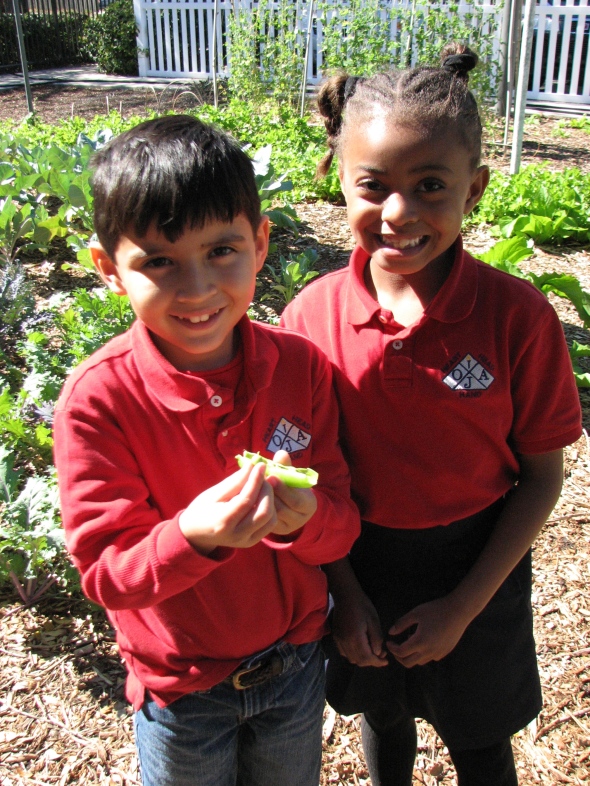
Inquiry-based Learning
“To be surprised, to wonder, is to begin to understand.” – Jose Ortega y Gassett.
If you surprise a child and inspire them to wonder, your job as an educator is nearly complete. (Teachers please don’t confuse your job as an educator with your other jobs: classroom manager, statistician, counselor, mediator and general miracle worker.) In the learning process nearly everything that comes after the inspiration of a really good question is the work of the student. This strawberry in a bottle sat on a table at the front of Mrs. Braga’s fourth grade class asking a question. The question was so obvious it didn’t even need to be verbalized. The answer, however, wasn’t quite so obvious. This question sat on the table all morning long, encouraging something we all long for children to experience, the struggle of challenging thought. It did this without the use of punishment or reward, without discipline or pleading.
After lunch the students had a long discussion about how this berry got in the bottle. All theories were entertained with respect, even the ones that fell quickly. Maybe the glass was cut. Maybe the berry was dehydrated than re-hydrated. Maybe it was shoved in really fast. The spectrum of ideas was broad. This conversation was lively and the debate was vigorous. The answer was discovered more than it was revealed and the students felt the pride of solving a problem.
The puzzle that this berry presented, though perhaps more obvious, is no less challenging and compelling than the puzzles that our students find in the garden and in nature. This problem solving approach immediately became a template for their discussion of strawberry pollination (a theory that after much consideration and debate was skeptically accepted) Too often we give children answers to questions they are not asking. If we can present the world to them without filling in all of the blanks, showing them just enough to inspire curiosity, education can become an engaging conversation and not just a lecture.
A Pickle’s Personal Narrative
Dark, tight and very very old. That’s the way my package had been for the last week, until finally the top of the bag ripped open! All of us cucumber seeds spilled out onto the desktop.
The next day I woke up to a blast of sunlight! I was in the hands of a fourth grader named Alex. I watched as my friends were poured into round pots filled with rich, black and fluffy soil then were covered up! Then it was my turn. I was dropped and I landed in the rich, black, fluffy soil and saw the last ray of sunlight as I was covered up.
One week later I pushed my way through the soil until I got to where the light passed through the dirt and finally I was in the sunlight again. I stood there for days and I waited and waited. I waited so long that when I gathered my thoughts I was taller than my friends! But I needed a new place to live. My roots were too crowded. Then I noticed the fourth graders building a trellis out of bamboo. I was so excited!
When I awoke the next morning I looked around me. I was right under the trellis. The soil felt better. I was so happy. When I measured myself again I was taller than Alex and full of cucumbers just waiting to be picked! When my cucumbers were picked, they were brought to the science lab where they were carefully chopped and placed in jars. Salt, vinegar and sugar were poured over me. Onions and sweet peppers were added to the mixture. Then I waited. When it was time the lid was unscrewed and out came pickles that would soon be eaten by the fourth graders and that’s how my life cycle went from seed to pickle.
The Winter Garden
Since it is now officially winter it seems reasonable to show a few pictures of our winter garden.
Winter is a great time to be in the garden at OJA. Gone is the glare of summer. The sun is hanging low in the southern sky and casts a gentler light on our plants. This blurs the line between edibles and ornamentals. Everything is more beautiful. A hay bale turns into a park bench. Thinking seems more like day dreaming and working in this softer sunshine seems more like play. Toil without sweat is a welcome change for students who tend to wilt a bit in the heat of August and September. If you’ve ever slogged through a tropical summer you know what golden days these are. It’s no “winter wonderland” but we’ll make do.


